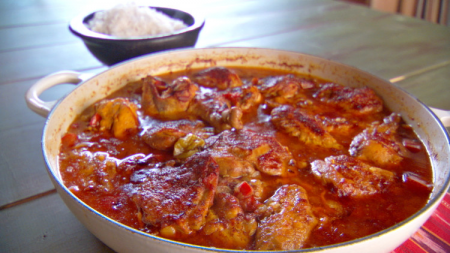Mama’s Punjabi Recipes: Murghi Turri Wali (CHICKEN CURRY)
 Although I am a vegetarian, this is the only non-vegetarian dish that I have ever made. Years ago, when my husband (who was also a vegetarian) and I were in the Indian Foreign Service, we would often have to entertain at our home and it was expected that there would be at least one non-vegetarian dish among all the others. Turri wali murgh (chicken curry) was a favorite of all, and especially of the kids, so, while we were posted in London, I learnt how to make it, though I would have someone else clean and cut it and have my children taste it while the curry was being prepared.
Although I am a vegetarian, this is the only non-vegetarian dish that I have ever made. Years ago, when my husband (who was also a vegetarian) and I were in the Indian Foreign Service, we would often have to entertain at our home and it was expected that there would be at least one non-vegetarian dish among all the others. Turri wali murgh (chicken curry) was a favorite of all, and especially of the kids, so, while we were posted in London, I learnt how to make it, though I would have someone else clean and cut it and have my children taste it while the curry was being prepared.
Chicken is the most common type of poultry in the world and is much easier to raise than cattle of hogs. As chicken is eaten worldwide in many different ways, it’s preparation has been adapted to regional tastes. Chicken is considered healthier than red meat as it has lower levels of cholesterol and saturated fat which is concentrated in the skin. Chicken contains 12.5% fat and 24.7% protein and 13% daily values of pantothenic acid (B5), 6% vitamin A, 9% iron and 4% sodium.
In India, chicken production has steadily gone up as household incomes have risen and people have added more meat to their diets. However, most meat is still sold in small butcher shops and chicken are kept fresh in cages till it is time to sell them, They are then slaughtered, the feathers plucked, and the meat cleaned and cut down into smaller pieces. The chickens are generally much smaller in India than those sold in the US.
Chicken curry usually follows the same preparation method as other curries, like chole (chickpeas) or aloo te mutter turi wale (potatoes and pea curry). But you have to pay attention to the cooking times, making sure that the curry flavor slowly seeps into the meat and that it is not overcooked.
Ingredients:
1 whole murghi (chicken) peeled and cut into pieces
1 large piyaaz (onion)
1 medium clump of adrak (ginger root)
1 medium kernel of lasan (garlic)
1 tablespoon of vegetable or olive oil
Tomato paste to taste
2 cups of pani (water)
Spices (to taste): namak (salt), mirch (red pepper), haldi (turmeric), dhania (coriander), garam masala
Directions:
1. Take the chicken out overnight to defrost. When thawed, remove the skin, cut into pieces and wash under running water. Let it drain in a colander.
2. Chop the ginger, onions and garlic and brown them in the oil in a saucepan. Add ½ a cup of water and let the gravy thicken up a bit and bring to a rapid boil.
3. Chop the tomato in chunks and add to the mixture and stir till the masala is soft and thick. Add the spices to your taste – if you have others you wish to use, add them too.
4. Add the chicken and stir it so that it is coated with the masala. Let it simmer for a minute.
5. While stirring, add half a tablespoon of tomato paste, to enhance the taste, texture and color.
6. The chicken will naturally shed some water, so keep the heat on low setting so that it does not burn and keep stirring till all the water is dried up and the meat has been roasted.
7. Add a little water at a time while the chicken is being roasted to allow more of the masala to seep into the meat. Then continue to stir till there is a thick gravy and the chicken becomes tender and the water is dried up.
8. Now add half a cup of water, cover and let the chicken simmer in it under low heat for 5 minutes.
9. Turn off the heat, let it cool for a few minutes. Carefully transfer into a bowl and sprinkle with the garam masala before serving.
MAMA’S TIP OF THE WEEK: MAKE SURE CHICKEN IS WARM INSIDE BEFORE COOKING
To make chicken curry, it is the tendency of many people to overcook it over high heat which only makes the meat tougher. On the other hand, some don’t brown the chicken enough, with the end result that it is tough from being raw inside. Cold chicken will not cook well and will take much longer to brown.
For the chicken curry to be moist and flavorful, it is important for the inside of the meat to be at room temperature so that the meat will readily accept the infiltration of spices. If you have doubts of the chicken temperature before cooking, place it in the microwave for a few seconds to ensure that the meat is warm on the inside.

Shakuntla Malhotra is a skilled cook of Punjabi dishes made in the old-fashioned style that she learnt as a young woman in her ancestral home in Lyallpur, India (since renamed Faisalabad) before it became part of Pakistan after the Partition in 1947. People have often admired her cooking for its simplicity and taste that comes with each mouthful. Even in her late-eighties, she continues to cook daily and agreed to share her delectable Punjabi recipes for future generations.
